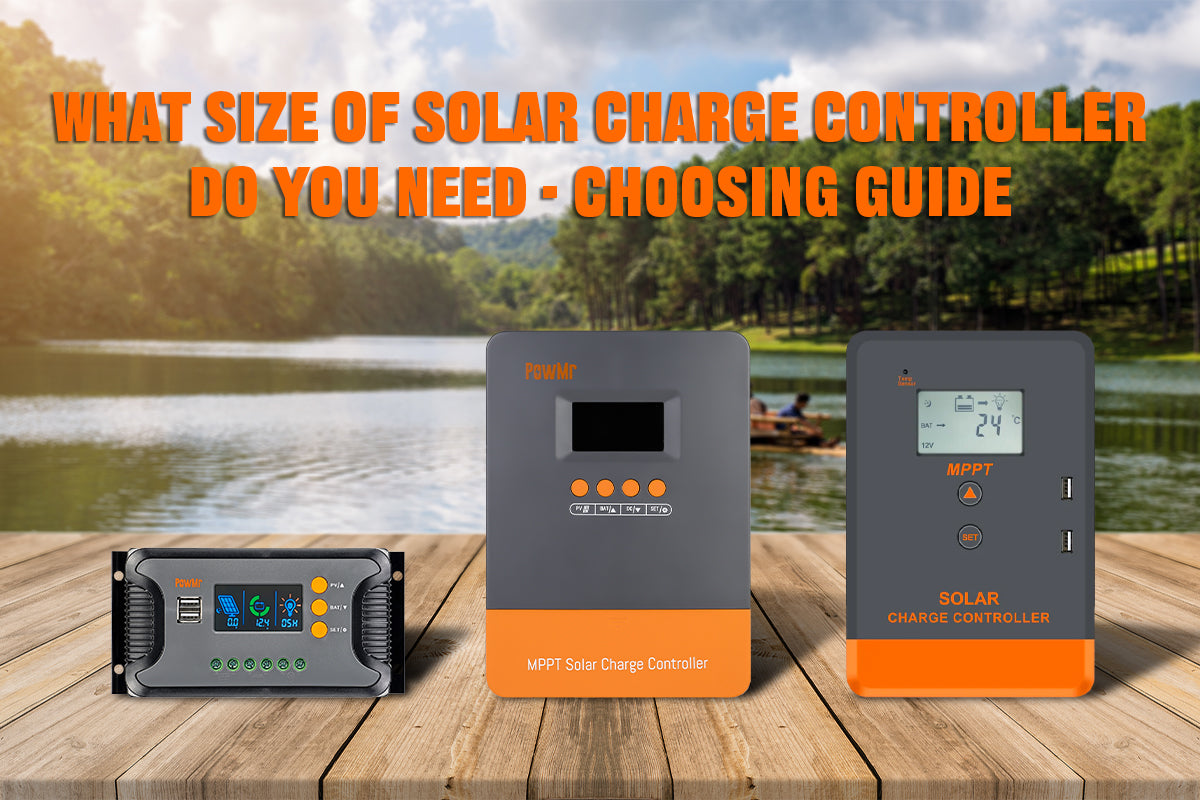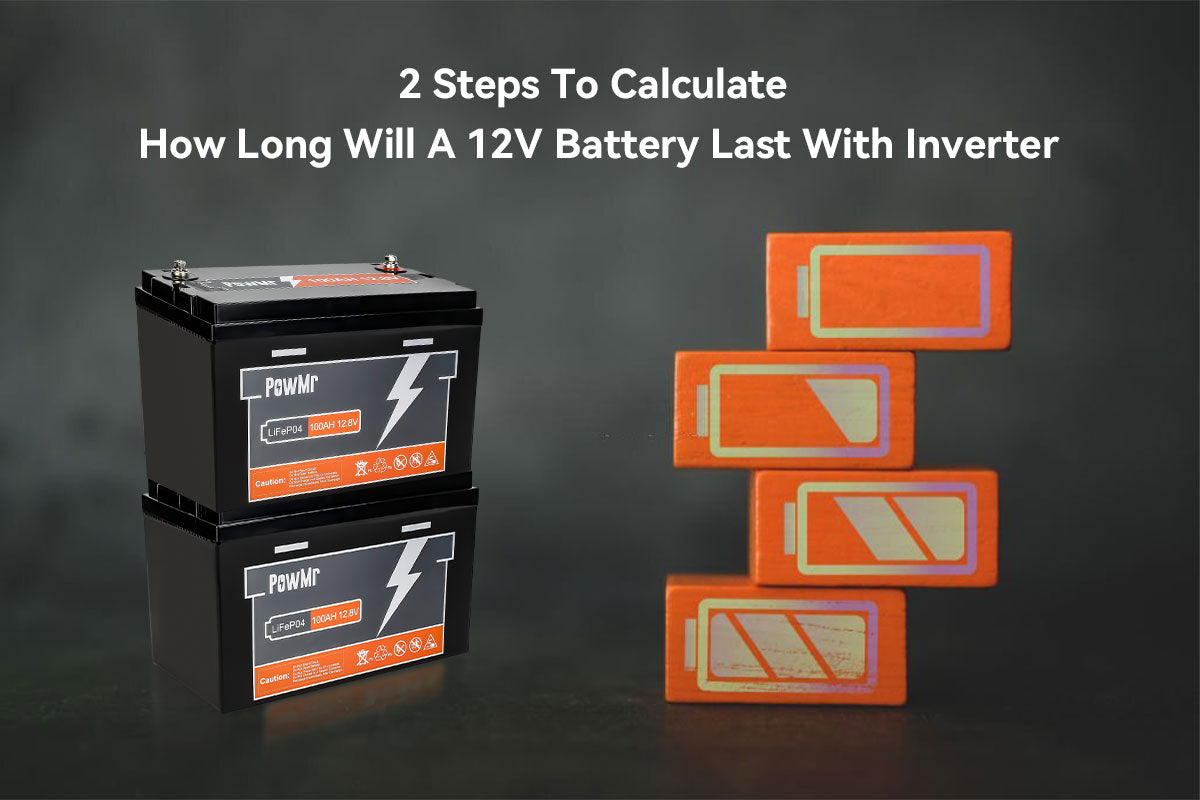In the realm of solar power, the solar charge controller is a vital device. It ensures efficient energy flow between panels and batteries, protecting them from damage.
This post covers how to choose the right solar charge controller by calculating the proper amperage and reviewing 4 key specifications that help prevent system damage and ensure long-term performance.
Calculate what amperage of solar charge controller is needed
To calculate the required amperage for a solar charge controller, start by dividing the total wattage of your solar array by the voltage of your battery system.
📌Note: Always ensure the selected controller’s charging current is below the battery system’s maximum allowable charging current.
Amperage = Solar Panel Wattage ÷ Battery Voltage
If you want more flexibility, consider choosing a charge controller with configurable charging current settings.
Below is an example showing the recommended solar charge controller size for various combinations of solar arrays and battery systems.
| Solar Panel Power | Battery Voltage | Controller Amperage (Rounded Up) |
|---|---|---|
| 1200W | 48V | 30A |
| 1000W | 24V | 50A |
| 500W | 12V | 50A |
| 300W | 12V | 30A |
| 250W | 12V | 30A |
| 100W | 12V | 10A |
Key specifications to consider when choosing solar charge controller
While calculating amperage gives you a good starting point, selecting the right solar charge controller goes beyond just basic math. To ensure long-term safety, compatibility, and system efficiency, you must also consider several critical specifications.
When choosing a solar controller, there are four key points to consider:
- Compatible battery type(s) and battery voltage.
- Maximum input power of the solar panels.
- Maximum input voltage of the solar panels.
- Maximum charging current of the battery.
Maximum charging current of the battery
Your solar charge controller must match the voltage of your battery bank, which is typically 12V, 24V, or 48V.
If you connect batteries in series, the total battery bank voltage changes — and your controller must align with that configuration to avoid undercharging or damaging the battery.
Some controllers support only a single voltage, while others are auto-detecting with preset charging parameters or offer manual selection across multiple voltages.
Maximum power input of the solar array
Every solar charge controller has a maximum wattage input from your solar panels. If the total wattage of your solar array exceeds this rating, it can lead to controller overheating, system instability, or permanent damage.
If the output of the solar array exceeds the capacity of a single charge controller, you can rearrange the solar array by using multiple charge controllers in parallel.
Maximum PV input voltage
This specification becomes crucial when wiring solar panels in series. The total voltage of your array is the sum of each panel’s open-circuit voltage (Voc). If this total exceeds the controller’s rated PV input voltage, it can cause failure.
It's wise to compare the temperature coefficient of the solar panel with the lowest recorded temperature in your location. This helps you estimate how high the Voc can rise in cold weather, when panel voltage increases significantly. Adjust the number of solar panels in series or parallel based on the charge controller's specifications.
Maximum charging current to the battery
This is the highest current the controller can send to your battery during charging. It must not only handle the array’s output but also stay within the battery manufacturer’s safe charging current range.
If the controller’s output exceeds what the battery can safely receive, it may reduce lifespan or trigger safety shutdowns.
MPPT solar charge controller sizing
Using the PowMr POW-M60-PRO MPPT controller as an example:

Key Point 1.
This 60 amp mppt solar charge controller can automatically recognize 12V/24V/36V/48V battery voltage systems, making it compatible with all four voltage options.
Key Point 2.
According to the specifications table above, the maximum input voltage from solar panels not exceed 160V DC, which means the open-circuit voltage of the connected solar panels in series should be equal to or less than 160V.
Key Point 3.
In a 48V system, the maximum input power from the solar panels is 2800W. The total power of the solar panel array connected to the controller should not exceed 2800W, as this could damage the controller.
Key Point 4.
To ensure proper operation, the controller rated charging current should not surpass the battery's maximum charging current allowance. With the POW-M60-PRO having a rated battery current of 60A, the connected battery must have a maximum charging current at least 60A or higher.
For example, PowMr's 48V 100Ah lithium battery can handle a maximum continuous charging current of 100A, making it a compatible choice for use with the POW-M60-PRO controller.
How do I know what solar charge controller to buy
The different working principles of PWM controllers and MPPT controllers lead to specific areas of application for each type.
If you find yourself in the following situations, a PWM solar controller would be a better choice:
- Small solar energy systems, such as installing lead-acid batteries in a camper, where the solar panel voltage closely matches the battery voltage.
- When charging efficiency is not a primary concern, such as maintaining the charge of marine batteries.
- Cost-saving installations, as PWM controllers are generally more budget-friendly.
On the other hand, MPPT solar controllers are better suited for the following scenarios:
- Regions with variable weather or harsh environments, as they can adapt to changing solar panel output and optimize energy capture throughout the day.
- Solar photovoltaic arrays with a higher voltage than the battery bank, ensuring safe charging and discharging.
- When aiming to maximize energy efficiency and output for cost-effectiveness, such as in commercial and industrial projects or residential solar setups with battery storage. MPPT controllers have a higher conversion rate for solar panels compared to PWM controllers and can absorb at least 30% more electricity.
Solar Charge controller Buying Guide Video
FAQs on Choosing Solar Charge Controller
Can a solar charge controller drain the battery?
A solar charge controller tipycally does not drain the battery, just drawn a little amount of energy from the solar panel or battery to maitain the operation of its internal electronics.
For example, POW-M60-ULTR has a self-consumption of 0.7 - 1.2W, which is negligible and won't meaningfully drain your battery.
Can I wire two solar charge controllers?
Yes, connecting two or more solar charge controller in parallel to one battery system provide a pratical solution in situation where the total output of the solar panels exceeds the capacity of the single charge controller.
Additionally, you should use a charge controller that supports parallel operation and install the system correctly.
Do I always need a solar charge controller?
Not always, but usually, solar panels output more than their nominal voltage. Only the tiniest panels, like 1 or 5-watt trickle chargers, can function without a controller.
What happens with an oversized solar charge controller?
Using an oversized solar charge controller can have both advantages and disadvantages. On the positive side, an oversized controller allows more current flow, which may be beneficial if you plan to expand your solar array in the future. It can also lead to reduced voltage drop and improved system efficiency.
However, the downsides include higher costs and potential inefficiency at lower solar panel capacities. Additionally, an oversized controller might not operate at its optimal efficiency level, resulting in wasted energy. Therefore, it is essential to carefully consider your system's requirements and balance the pros and cons before choosing a solar charge controller.



